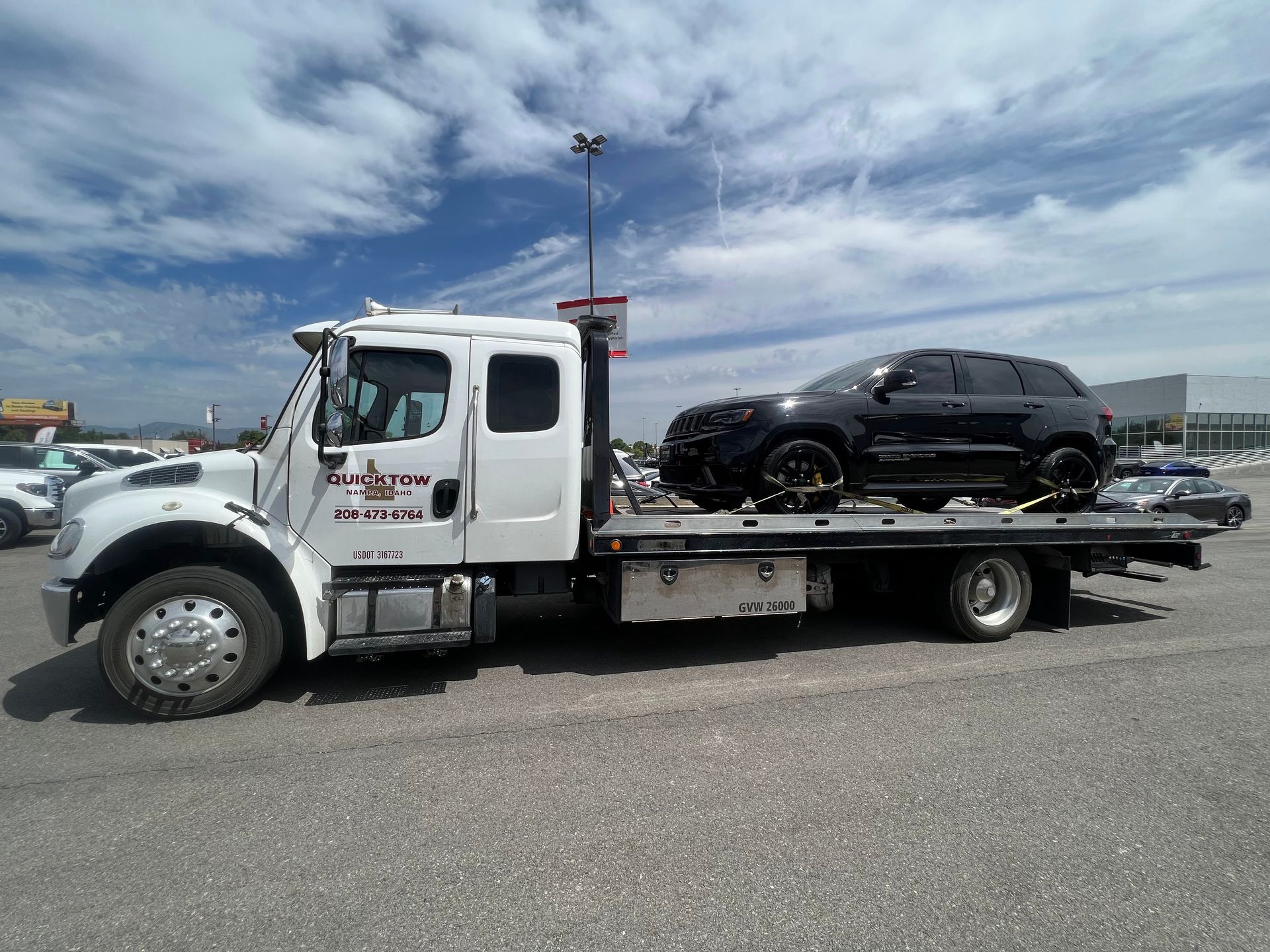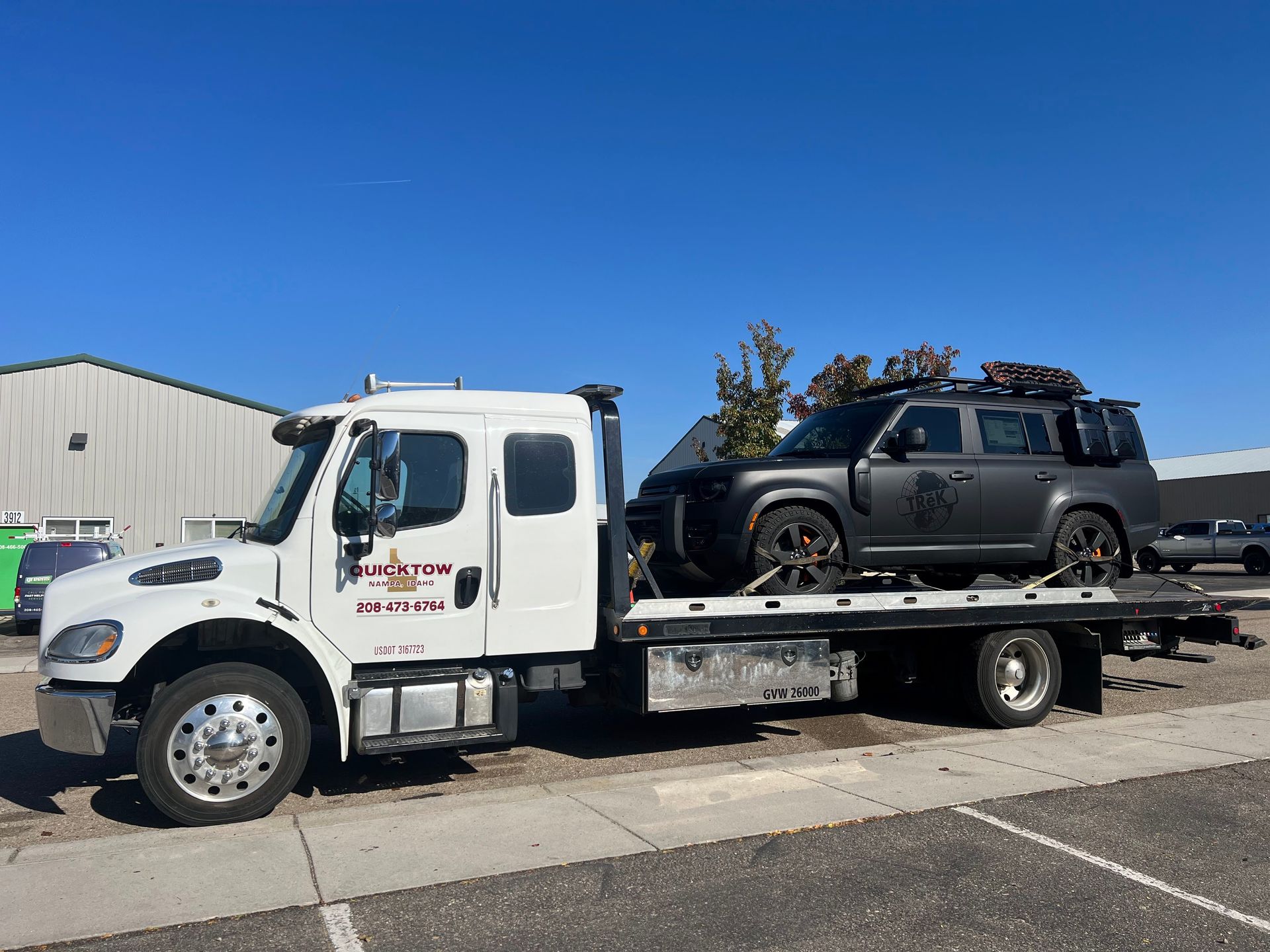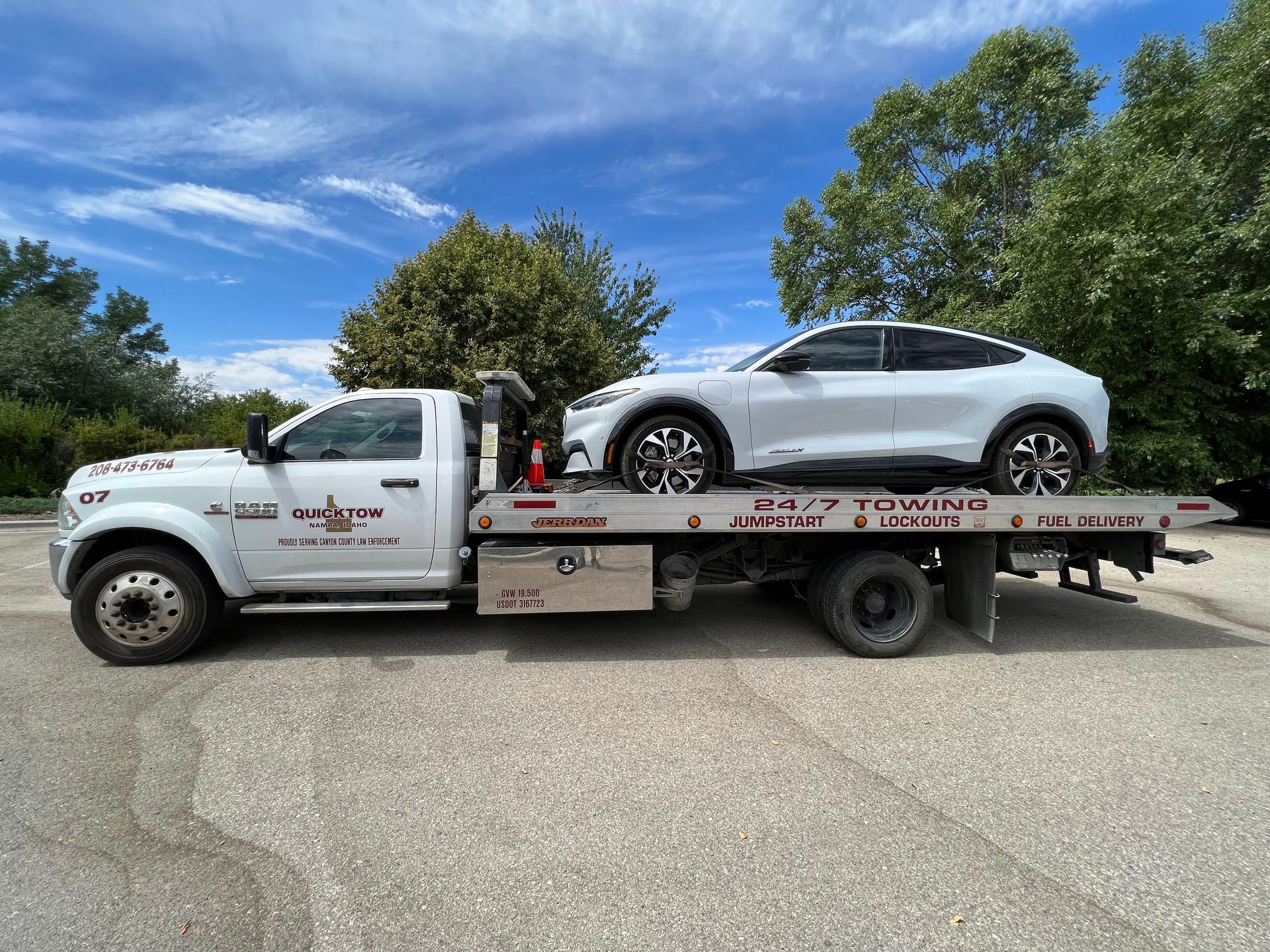Quality. Safety. Efficiency.
Flat Tire on the Highway? Here’s What to Do
A flat tire is never fun to deal with, but a flat tire on the highway can put you and other drivers in danger. Whether it has a slow leak or the tire has blown out completely, you need to take care of your flat ASAP. Do you know what to do when you have a flat tire on the highway?
Not to fear! In this post, we’ll explain exactly what to do in case you find yourself in this scary situation.
If you currently have a flat tire on the highway or if you get one in the future, give us a call at (208) 473-6764 or click the button below. We serve the entire Treasure Valley including Meridian, Boise, Caldwell, and Middleton.
Flat Tire on Highway
You’re flying down the freeway at sixty plus miles per hour when all of a sudden, your car starts thumping or pulling to one side. You know you have a flat, so here’s what to do:
- Stay calm and don’t panic. You need to keep a steady hand on the steering wheel.
- Gradually slow down and pull over onto the shoulder.
- Turn on your hazard lights. This makes your vehicle more visible to other drivers.
- Engage the parking brake. You may also want to place a rock by your wheels to prevent the car from rolling.
- Stay inside the vehicle while you assess the situation. The shoulder of a highway can be very dangerous.
- Call for help.
- Change your tire, if it’s safe and you’re able.
How to Change a Tire
Changing a tire is a fairly simple process, but it can require a lot of strength. Still, it’s definitely something you can do, as long as you have the tools. Here’s a stop by step process for changing a flat tire on the highway.
- Assess the damage. If the tire is severely damaged, it may be better to call for assistance.
- Grab your spare tire, lug wrench, and jack.
- Place the jack under the frame. The correct position depends on your vehicle, so make sure to read the owner’s manual.
- Raise the vehicle slightly off the ground. Check that it’s stable before fully lifting your car. Note that you only need to lift it high enough to replace the tire.
- Use the lug wrench to loosen and remove lug nuts from the tire. This can take a lot of strength, so be prepared to sweat. Once removed, make sure to place the lug nuts somewhere secure, such as in the hubcap or in your pocket.
- Remove the flat tire. It should come off fairly easily, but you may need to wiggle it slightly.
- Put the spare tire on the hub. Tighten the lug nuts by hand.
- Using the lug wrench, tighten the lug nuts in a star pattern to ensure even pressure.
- Slowly lower the vehicle until it’s securely on the ground. Tighten the lug nuts one last time.
- Check the tire pressure on the spare to make sure it’s adequately inflated.
- Gather up your tools as well as the flat tire. You might be able to repair the tire.
- You can now continue driving, but note that you’ll need to take it slow.
- Spare tires aren’t meant for long-term use. Make sure you visit a tire shop as soon as possible.
Where to Park
If you find yourself with a flat tire on the road, you need to stop your vehicle as quickly and safely as you can. In most cases, it’s illegal to stop on the side of a highway, but because this is an emergency, you’re allowed to use the shoulder. The right side of the highway is better than the left, but only if you can make it there safely. If an exit ramp is nearby, try to make it to the ramp and park on the shoulder.
When you park, move your vehicle as far from the highway as you can. Many people will move to the left to give you space, but it’s better to be safe than sorry.
How to Drive When the Tire Goes Flat
Driving on a flat tire is dangerous, and even driving a short distance can damage your vehicle. Still, you might be in the middle of the freeway when you realize you have a flat. If this happens to you, you’ll want to remember these tips to stay safe.
- Grip your wheel firmly. The flat tire is going to pull your car a bit, especially if it’s on the front. Holding the wheel firmly will help you stay in your lane.
- Slow down gradually. Braking suddenly can put you at risk for a collision with other vehicles on the highway.
- Pull over as soon as you can.
How to Know if Your Tire is Flat
When it comes to having a flat tire on the highway, the faster you deal with it, the better. Driving on a flat tire could further damage the tire, making it impossible to repair. Plus, you might damage the wheel, which is much more costly to fix. That’s why it’s important to recognize the signs that your tire is flat. Here are some symptoms of a flat tire you may notice:
- Vibration or shaking: If you suddenly feel strong vibrations in the steering wheel or even throughout the whole car, you may have a flat tire.
- Pulling to one side: Sometimes, when you have a flat, your vehicle will pull to one side, making you feel like the car is trying to veer off course.
- Sudden loss of air pressure: A loud pop or hissing sound while driving is a pretty good indication that you’ve had a blowout.
- Loss of control: If you find it hard to steer your car, this is another indication you may have a flat.
- Noise: Sometimes, a flat or damaged tire will make a flapping or thumping noise.
- Low tire pressure warning light: Since 2007, every vehicle is required to come with a Tire Pressure Monitoring System to alert drivers when their tires are losing air pressure. If your tire loses pressure, the TPMS will illuminate the warning light on your dashboard.
- Loss of tire pressure over time: If you find yourself constantly needing to add air to one of your tires, you may have a leak or puncture.
Who to Call
As long as you have the right tools and can safely change the tire, you can probably handle a flat tire on the road all by yourself. However, if you’re unsure about how to change a tire or don’t have the tools, it’s a good idea to call someone. Make sure you’re parked safely on the shoulder before dialing any numbers.
- Friend or family member: If you don’t have the right tools or just want some help, calling a friend or family member can be a good idea. However, you’ll have to rely on their availability, meaning you could be waiting for hours. If you’re traveling out of town, you may not have anyone nearby you can call.
- Insurance: If your insurance has a roadside assistance policy, now is a good time to call them. They may provide a tow truck or send someone who can help you change your tire.
- Tow truck company: If you don’t have the right tools or if you feel unsafe, it’s a good idea to call a professional tow truck company like QuickTow and Recovery. We offer 24/7 towing and roadside assistance, including highway tire changes.
How to Avoid Getting a Flat Tire
Getting a flat tire isn’t the worst thing that can happen to your vehicle, but it rarely happens at a convenient time. Luckily, there are steps you can take to avoid flat tires when you’re driving.
- Rotate your tires regularly. This ensures that your tires wear evenly and are less susceptible to flat tires on the road.
- Proper tire maintenance is key. Check your tire pressure once a month and keep them inflated to the levels recommended by your owner’s manual.
- Inspect tires for damage routinely. Cuts, punctures, bulges, or cracks in the sidewall are all signs that your tire needs to be looked at by a professional.
- Avoid road hazards. Potholes, debris, and curbs can all damage your tires.
- Watch for overloading. Putting too much pressure on your tires by overloading your vehicle leads to wear and tear and higher risk of flat tires on the highway.
If you find yourself on the highway with a flat tire, QuickTow and Recovery is here to help. We offer 24/7 roadside assistance, meaning we’ll be there whether it’s 3 p.m or 3 a.m. We can help you change your flat or tow your vehicle to a repair shop.
VISIT US
OFFICE HOURS
Monday - Friday 9:00 AM - 5:00 PM
CONTACT US
Call or Text




